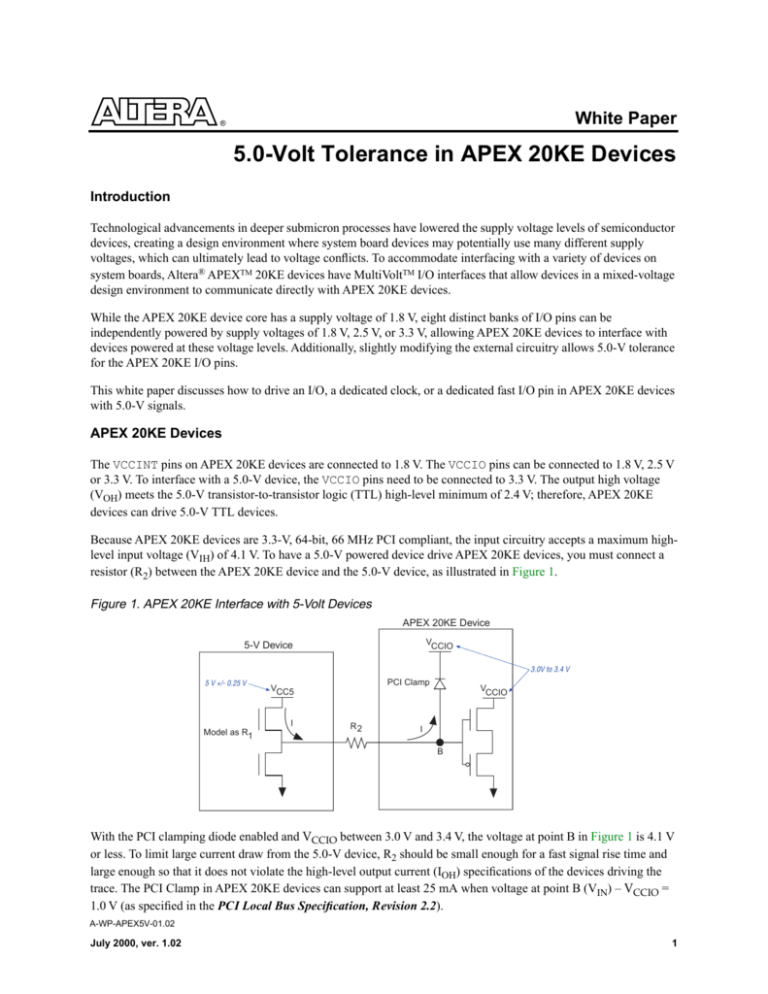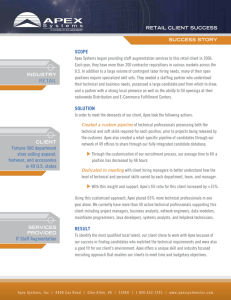
White Paper
®
5.0-Volt Tolerance in APEX 20KE Devices
Introduction
Technological advancements in deeper submicron processes have lowered the supply voltage levels of semiconductor
devices, creating a design environment where system board devices may potentially use many different supply
voltages, which can ultimately lead to voltage conflicts. To accommodate interfacing with a variety of devices on
system boards, Altera® APEXTM 20KE devices have MultiVoltTM I/O interfaces that allow devices in a mixed-voltage
design environment to communicate directly with APEX 20KE devices.
While the APEX 20KE device core has a supply voltage of 1.8 V, eight distinct banks of I/O pins can be
independently powered by supply voltages of 1.8 V, 2.5 V, or 3.3 V, allowing APEX 20KE devices to interface with
devices powered at these voltage levels. Additionally, slightly modifying the external circuitry allows 5.0-V tolerance
for the APEX 20KE I/O pins.
This white paper discusses how to drive an I/O, a dedicated clock, or a dedicated fast I/O pin in APEX 20KE devices
with 5.0-V signals.
APEX 20KE Devices
The VCCINT pins on APEX 20KE devices are connected to 1.8 V. The VCCIO pins can be connected to 1.8 V, 2.5 V
or 3.3 V. To interface with a 5.0-V device, the VCCIO pins need to be connected to 3.3 V. The output high voltage
(VOH) meets the 5.0-V transistor-to-transistor logic (TTL) high-level minimum of 2.4 V; therefore, APEX 20KE
devices can drive 5.0-V TTL devices.
Because APEX 20KE devices are 3.3-V, 64-bit, 66 MHz PCI compliant, the input circuitry accepts a maximum highlevel input voltage (VIH) of 4.1 V. To have a 5.0-V powered device drive APEX 20KE devices, you must connect a
resistor (R2) between the APEX 20KE device and the 5.0-V device, as illustrated in Figure 1.
Figure 1. APEX 20KE Interface with 5-Volt Devices
APEX 20KE Device
VCCIO
5-V Device
3.0V to 3.4 V
5 V +/- 0.25 V
I
Model as R1
PCI Clamp
VCC5
R2
VCCIO
I
B
With the PCI clamping diode enabled and VCCIO between 3.0 V and 3.4 V, the voltage at point B in Figure 1 is 4.1 V
or less. To limit large current draw from the 5.0-V device, R2 should be small enough for a fast signal rise time and
large enough so that it does not violate the high-level output current (IOH) specifications of the devices driving the
trace. The PCI Clamp in APEX 20KE devices can support at least 25 mA when voltage at point B (VIN) – VCCIO =
1.0 V (as specified in the PCI Local Bus Specification, Revision 2.2).
A-WP-APEX5V-01.02
July 2000, ver. 1.02
1
Altera Corporation
5.0-Volt Tolerance in APEX 20KE Devices White Paper
To compute the required value of R2, first calculate the model of the pull-up transistors on the 5.0-V driving device.
This output transistor can be modeled as a resistor (R1). To compute R1, divide the supply voltage (VCC5) by the IOH
V
I OH
CC5
as in the following equation: R 1 = -------------
Refer to the specific 5.0-V device’s data sheet for its output drive characteristics. Figure 2 shows an example of the
typical output drive characteristics of a 5.0-V device.
Figure 2. Example Output Drive Characteristics of a 5.0-V Device
150
IOL
135
120
Typical IO
Output
Current (mA)
VCCINT = 5.0 V
VCCIO = 5.0 V
Room Temperature
90
60
IOH
30
1
2
3
4
5
VO Output Voltage (V)
5.0V
For the device in Figure 2, R 1 = ------------------ . Because data sheet values are shown at typical conditions, subtract 20%
135mA
from the data sheet value for guard band. This subtraction applied to the above example gives R1 a value of 30 Ω.
R2 should be chosen so as not to violate the IOH specification of the driving device. Consider a device where the
maximum IOH = 8 mA. Due to the PCI Clamp, VIN = VCCIO + 0.7 V. The minimum VIN = 3.0 V + 0.7 V = 3.7 V. The
maximum VCC5 of the 5.0-V device = 5.25 V. Therefore, to compute R2, use the following equation:
( 5.25V – 3.7V ) – ( 8mA × 30Ω )
R 2 = -------------------------------------------------------------------------------- = 164Ω
8mA
This analysis employs worst-case conditions. If your system will not see a wide variation in voltage supply levels,
you may adjust accordingly.
Quartus Implementation
To interface APEX 20KE devices with 5.0-V devices, the optional PCI Clamp in the APEX 20KE I/O Element must
be enabled. To enable the PCI clamping diode, go to the Quartus software’s Assignment Organizer (Tools Menu)
dialog box, click Options for Individual Nodes & Entities, and set the PCI I/O logic option to ON.
Hot-Socketing
APEX 20KE devices are designed to support hot-socketing without special design requirements. Signals can be
driven into APEX 20KE devices before and during power-up without damaging the device. In addition, APEX 20KE
devices do not drive out during power-up.
2
Altera Corporation
5.0-Volt Tolerance in APEX 20KE Devices White Paper
However, do not drive 5.0-V signals into APEX 20KE devices before the device is configured because the PCI
clamping diode is not activated until configuration is complete.
For details on hot-socketing, see Application Note 107 (Using Altera Devices in Multiple-Voltage Systems).
Power Sequencing
APEX 20KE devices have been specifically designed to tolerate any possible power-up sequence. Therefore, the
VCCIO and VCCINT power planes may be powered in any order.
See the APEX 20KE Programmable Logic Devices Errata Sheet for additional information.
Conclusion
APEX 20KE devices have MultiVolt I/O support, allowing 1.8-V, 2.5-V, and 3.3-V devices to interface directly with
APEX 20KE devices without causing voltage conflicts. In addition, APEX 20KE devices can interface with 5.0-V
devices by slightly modifying the external hardware interface and enabling PCI clamping diodes via the Quartus
software.
®
101 Innovation Drive
San Jose, CA 95134
(408) 544-7000
http://www.altera.com
Copyright 2000 Altera Corporation. Altera, APEX, APEX 20KE, Quartus, and MultiVolt are trademarks and/or service marks of Altera
Corporation in the United States and other countries. Other brands or products are trademarks of their respective holders. The specifications
contained herein are subject to change without notice. Altera assumes no responsibility or liability arising out of the application or use of any
information, product, or service described herein except as expressly agreed to in writing by Altera Corporation. Altera customers are advised
to obtain the latest version of device specifications before relying on any published information and before placing orders for products or
services. All rights reserved.
3








